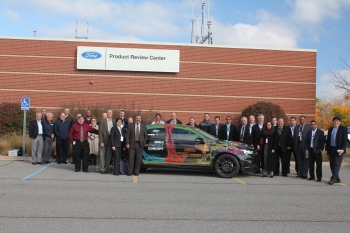
A team of vehicles experts was present during the crash test for Ford and Magna's Multimaterial Lightweight Vehicle.
Most owners aren’t itching to crash their car. But most cars aren’t the Multi-Material Lightweight Vehicle (MMLV), a concept vehicle designed by Ford and Magna under a project funded by the Department of Energy’s Vehicle Technologies Office. This unique concept car weighs nearly 25 percent less than the 2013 Ford Fusion, a similar midsized sedan. Reducing a vehicle’s weight by 10 percent can increase its fuel economy by 6 to 8 percent, so the technology in the MMLV offers huge potential for increasing vehicle efficiency. To better understand how lightweight materials act in real-life situations, Ford recently ran the vehicle through one of the National Highway Traffic Safety Administration’s standard crash tests at Ford’s Proving Grounds in Dearborn, MI.
For the New Car Assessment Program’s Full Frontal Crash Test, Ford ran the MMLV into a wide, rigid, barrier at 35 miles per hour. As frontal crashes are the most common cause of fatalities, this test is essential for evaluating how well a vehicle can protect its passengers. This test is only the first one of four that the team will perform to access the structural integrity of the vehicle.
While Ford is unlikely to ever sell a copy of the MMLV, performing these crash tests on it will allow them to compare it to similar cars made with conventional materials. Analyzing this data will help Ford and Magna determine if this vehicle meets or exceeds safety requirements, one of the main project goals. If the test does reveal any issues, the data will help the research team improve the technology in the future. Besides the crash tests, the research team and their partners at the Department of Energy also ran the MMLV through its paces on Ford’s test track to assess its handling, performance, and interior noise level.
This project and test is a major step forward for the use of lightweight materials in vehicles. Although many vehicles on the market use small amounts of lightweight materials, their high cost had previously made them too expensive to use extensively. While most vehicles are almost 50 percent conventional steel, this vehicle largely uses advanced high-strength steel, aluminum, and magnesium for the body. It also uses carbon fiber composites in interior components like seats and suspension components like wheels. Because a lighter vehicle requires less work from the engine, Ford was able to downsize the powertrain, further increasing the vehicle’s efficiency. Now that Ford and Magna have developed this car, they can integrate the technologies and lessons learned about these materials into existing and future models.
This project is only one of many that the Vehicle Technologies Office supports to advance lightweight vehicle technology. In fact, using lightweight components and high-efficiency engines enabled by advanced materials in just a quarter of vehicles on the road could save more than 5 billion gallons of fuel annually by 2030. The Vehicle Technologies Office’s research and development focuses on lowering the cost of these materials, increasing their ability to be recycled, and improving their integration into vehicles.
With the MMLV having smashed into physical barriers and through technological ones, it will have an impact on transportation for decades to come.


